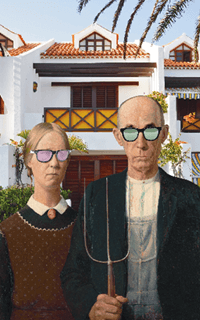A national and local look at how the vacation- and second-home market is faring.
By Gayle Bennett
Nationally, an estimated 1.13 million vacation homes were sold last year, a 57.4 percent increase from 2013, according to National Association of REALTORS® 2015 Investment and Vacation Home Buyers Survey. The overall share of vacation-home sales also grew dramatically, to 21 percent compared with 13 percent in 2013. These numbers are the highest since NAR began conducting the survey in 2003.
NAR attributes this markets growth to baby boomers, who have benefited from consecutive years of strong stock and housing markets since the recession. The bulk of this demographic sees retirement in the not-too-distant future, and many are buying vacation homes that will soon become their primary residences.
According to the NAR second-home survey, 40 percent of vacation buyers purchased homes in a beach area, 19 percent in the country and 17 percent in the mountains. The Residential Specialist asked CRSs who cover each of those areas to share how their markets have changed since the downturn, describe their typical buyers and predict how they think the year will shake out.
THE MARKET SINCE THE RECOVERY
While 2014 was a strong year for sales, the overall median price of vacation homes slipped 11 percent to $150,000 from $168,700 in 2013. NAR attributes that decline to increases in condo and townhouse sales, an increase in distressed property sales and an uptick in sales in the South, where prices are often lower.
Bruce and Sandy Soli, both CRSs with Sierra Sothebys International Realty, work in the Lake Tahoe area of Nevada and California. Their market is a mix of single-family homes, planned-unit developments and condos. Prices range from around $400,000 to $35 million, with the most active piece of the market between the $600,000 and $1.2 million price points.
Prices in Lake Tahoe fell from 2008 to 2010 due to the distressed properties that filtered their way into the market, but many sellers opted to remove their homes from the market rather than discount them further. They didnt feel the need to sell because when they buy homes in Tahoe, they are buying more of a lifestyle than an investment, says Bruce Soli.
Year-over-year sales were down in 2014 345 total sales compared to 443 in 2013. The Solis attribute this mainly to tighter inventory. The median price in Tahoe tends to vary wildly from year to year, given the range of real estate. The median will be skewed heavily when we have a lot of luxury sales, Sandy Soli says. Last year, demand was strong and supply was low, which has remained the story this year so far.
In the Fort Myers area of Florida, distressed properties were a huge portion of the overall market coming out of the downturn. But like Lake Tahoe, there werent that many homebuyers in the second-home market, according to Michael Polly, CRS, vice president of real estate operations with Royal Shell Real Estate. The second-home market was affected, but nothing like the primary home and investor market, he says. There were a lot of other factors that kept buyers sitting on the fence. He cites the hit people took in their other real estate holdings and the 2010 Gulf oil spill, which even though it didnt affect the Ft. Myers area, nonetheless depressed sales activity.
Last year, sales and median price were up in almost all the vacation-home areas from Marco Island to Captiva Island. Weve seen about a 20 percent increase in sales of homes that sell above $500,000, says Polly, indicating the lower price point of most vacation homes in his area that are close to the beaches. Weve seen that for 2014 over 2013 and in the first quarter of 2015 over 2014.
Kay Pearson, CRS, associate broker with the Pearson Group, also works in Florida, but only in the winter. Starting in April and through the summer, she works in the Lincoln and Hubbard Lake areas of Northeastern Michigan. Her primary focus there is the Lost Lake Woods Club, a private, gated club that started in the 1920s as a hunting and golf community.
As was the case in most of Michigan, the downturn hit this area hard. These second homes became unfeasible because of the automotive downturn, Pearson says. People had trouble with their primary homes, so the second-home market just wasnt happening. But since the downturn, the average sale price has been climbing from $81,831 in 2009 to $115,721 in 2014 and the number of sales last year was 21, compared to eight in 2009.
Second HelpingsAmong all homebuyers in 2014, the number of buyers purchasing a primary residence declined, but the market share of buyers of vacation homes continued to rise. |
||
|---|---|---|
| 2014 | 2013 | |
| Number of sales | 1.13 million | 717,000 |
| Share of all transactions | 21% | 13% |
| Median price | $150,000 | $168,700 |
| Cash sales | 30% | 38% |
| Distressed property sales | 45% | 42% |
| Median buyer income | $94,380 | $85,600 |
| Median distance from primary residence | 200 miles | 180 miles |
WHO IS THE SECOND-HOME BUYER?
According to the NAR second-home survey, 33 percent of vacation homebuyers plan to use their property for vacations or retreats, 19 percent plan to convert their vacation home into their primary residence in the future, 13 percent bought for potential price appreciation and 13 percent purchased because they found a good deal.
Most of the Solis buyers fall into the first two categories, although there can be some overlap. Our largest feeder market is the Bay Area, Sandy Soli says. They can get in and out of the car and come here multiple times a year. Given that we are a tax-friendly state, we also attract second-home buyers from other tax-friendly states like Florida and Texas.
Polly says there are two typical buyers in his second-home market. We have buyers who have generational wealth in that baby boomer generation who arent looking to spend any more winters in the Midwest or the North. The other buyer is the one who is nearing retirement and wants to purchase now. They will use the property first as an income property to help offset the cost of ownership, carving out a few weeks for personal use as a vacation property. Florida doesnt have a state income tax, and thats a nice 6 to 8 percent savings for people.
He says that 68 percent of sales $500,000 and over are cash sales. This market has predominantly been a cash market, so this is normal.
People come to Northeastern Michigan to escape the tri-county (Detroit) area, Pearson says. Their decision to buy is likely based on what they like to do in the country or on a lake: hunt, fish, boat, kayak or some other activity. Its always about dissecting their lifestyle, she says.
HOW WILL 2015 WRAP UP?
Pearson expects 2015 to be another strong year in her area of Northeastern Michigan. Finally people downstate can sell for more money, and they can move upstate and buy so much more for their money, she says. Theres a trailing effect thats taking place.
With the Tahoe areas low inventory and high demand, the Solis are likely to see sales prices continue to increase. However, Bruce Soli points out that since many owners in their market dont have to sell, they often put their homes on the market at an inflated price. He calls them recreational sellers. Theres a bit of a disconnect with some of the pricing, he says. When people are looking to buy, I recommend they stretch their price point during the search. What they are looking for is probably available; however, it might just be overpriced.
Polly also expects 2015 to end on a high note in terms of both sales and price. After all, he says, Florida has three key things that people like in a vacation home: Warmth, water and way of life: People are drawn to that.
For more information, look for NARs Field Guide to Vacation, Resort, and Second Homes, available at REALTOR.org.








